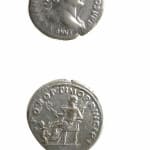Silver Denarius of Emperor Trajan, 98 CE - 117 CE
Silver
C.5895
Further images
Obverse: IMP TRAIANO AVG GER DAC PM TR P COS V PP; Laureate Bust of the Emperor Facing Righ Reverse: SPQR OPTIMO PRINCIPI; Pax, Bare Chested, Seated to the Left,...
Obverse: IMP TRAIANO AVG GER DAC PM TR P COS V PP; Laureate Bust of the Emperor Facing Righ
Reverse: SPQR OPTIMO PRINCIPI; Pax, Bare Chested, Seated to the Left, Holding a Branch and a Sceptre, a Dacian Kneeling Before Her
Trajan was born in 53 A.D. to a family of Roman origin residing in Itálica (near modern Sevilla, Spain). Conqueror of Dacia (modern Romania) and Mesopotamia, he ruled the Roman Empire from the year 98 until his death in 117. He was trained as a youth in the Roman army and took an active part in campaigns in Spain, Syria, and Germany during the reigns of the emperors Titus and Domitian. Trajan achieved distinction as a general of outstanding ability, and in 91 he was elected a consul. In 97, he was adopted by Emperor Nerva as his colleague and successor. On the death of Nerva the following year, Trajan, who was at that time inspecting the Roman frontier in Germany, became the sole ruler of the empire.
How many hands have touched a coin in your pocket or purse? What eras and lands have the coin traversed on its journey into our possession? As we reach into our pockets to pull out some change, we rarely hesitate to think of who might have touched the coin before us, or where the coin will venture to after it leaves our hands. More than money, coins are a symbol of the state that struck them, of a specific time and location, whether contemporary currencies or artifacts of a long forgotten empire. This stunning hand-struck coin reveals an expertise of craftsmanship and intricate sculptural detail that is often lacking in contemporary machine-made currencies. Numerous monuments scattered throughout the Roman Empire today bear testimony to Trajan’s reign. However, perhaps no ruin is as personal and intimate as this coin. Although simple in form and function, void of any grandeur or pomposity, this coin is not a stagnant memorial but an active artifact of a leader passed from the hands of civilization to civilization, from generation to generation.
Reverse: SPQR OPTIMO PRINCIPI; Pax, Bare Chested, Seated to the Left, Holding a Branch and a Sceptre, a Dacian Kneeling Before Her
Trajan was born in 53 A.D. to a family of Roman origin residing in Itálica (near modern Sevilla, Spain). Conqueror of Dacia (modern Romania) and Mesopotamia, he ruled the Roman Empire from the year 98 until his death in 117. He was trained as a youth in the Roman army and took an active part in campaigns in Spain, Syria, and Germany during the reigns of the emperors Titus and Domitian. Trajan achieved distinction as a general of outstanding ability, and in 91 he was elected a consul. In 97, he was adopted by Emperor Nerva as his colleague and successor. On the death of Nerva the following year, Trajan, who was at that time inspecting the Roman frontier in Germany, became the sole ruler of the empire.
How many hands have touched a coin in your pocket or purse? What eras and lands have the coin traversed on its journey into our possession? As we reach into our pockets to pull out some change, we rarely hesitate to think of who might have touched the coin before us, or where the coin will venture to after it leaves our hands. More than money, coins are a symbol of the state that struck them, of a specific time and location, whether contemporary currencies or artifacts of a long forgotten empire. This stunning hand-struck coin reveals an expertise of craftsmanship and intricate sculptural detail that is often lacking in contemporary machine-made currencies. Numerous monuments scattered throughout the Roman Empire today bear testimony to Trajan’s reign. However, perhaps no ruin is as personal and intimate as this coin. Although simple in form and function, void of any grandeur or pomposity, this coin is not a stagnant memorial but an active artifact of a leader passed from the hands of civilization to civilization, from generation to generation.





